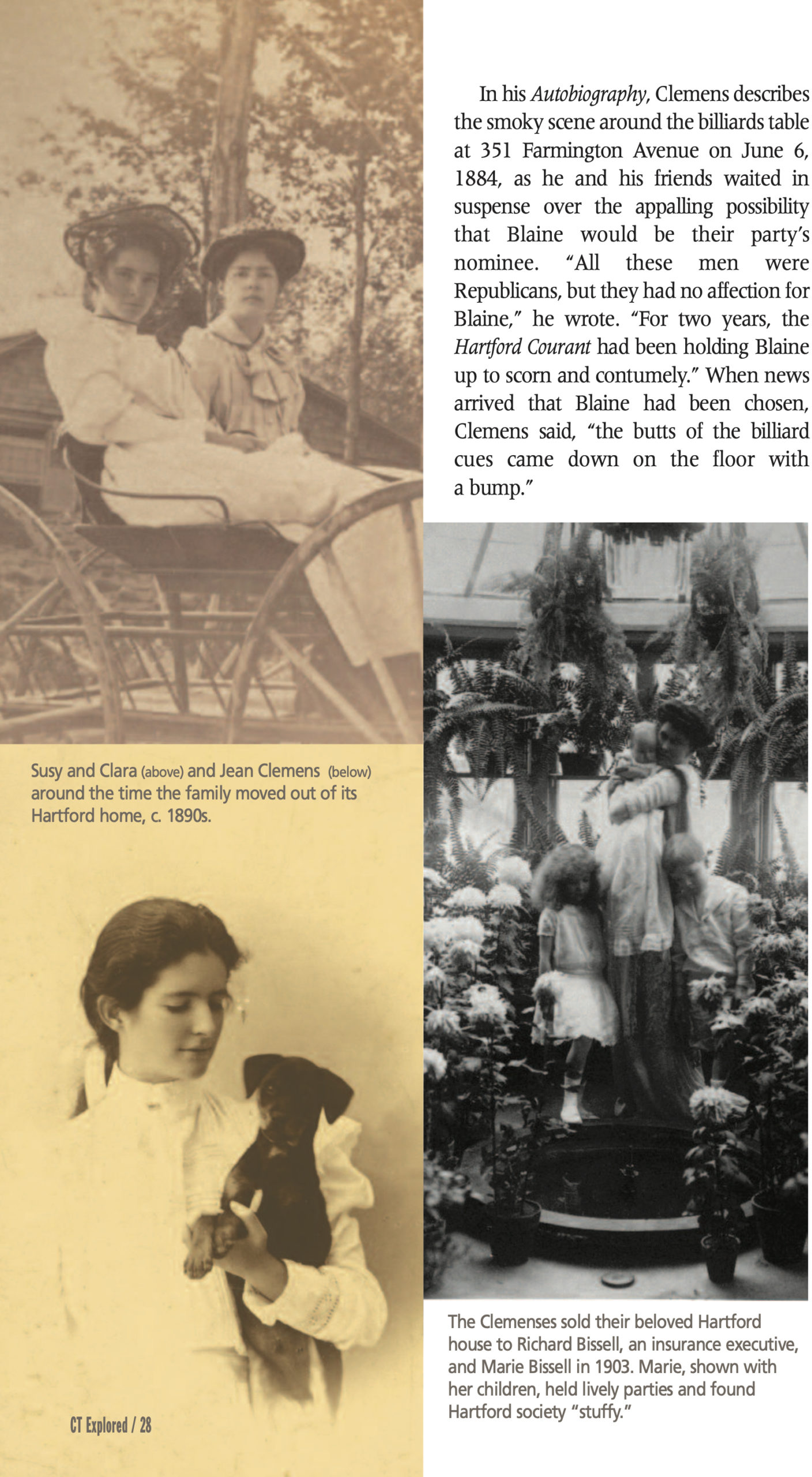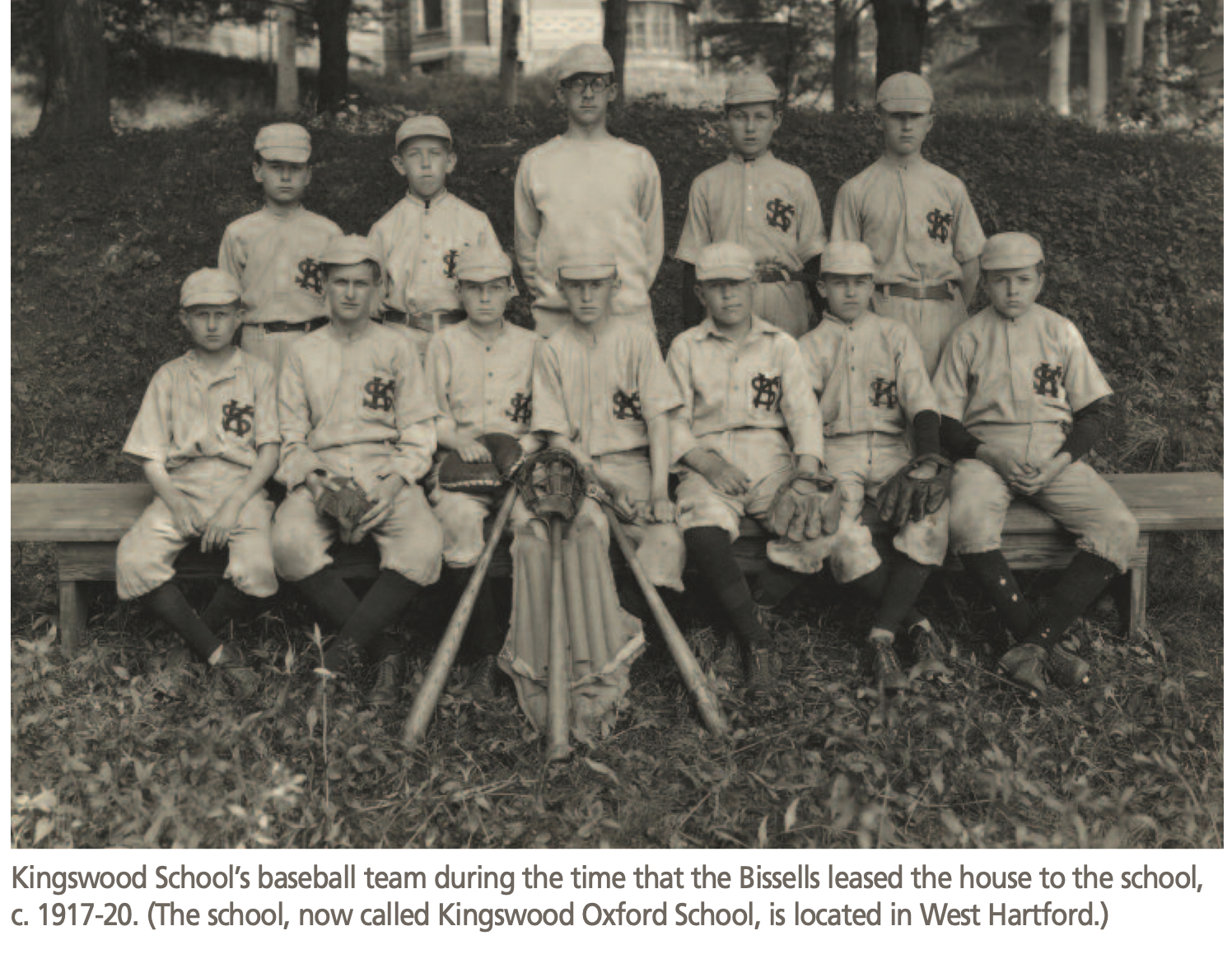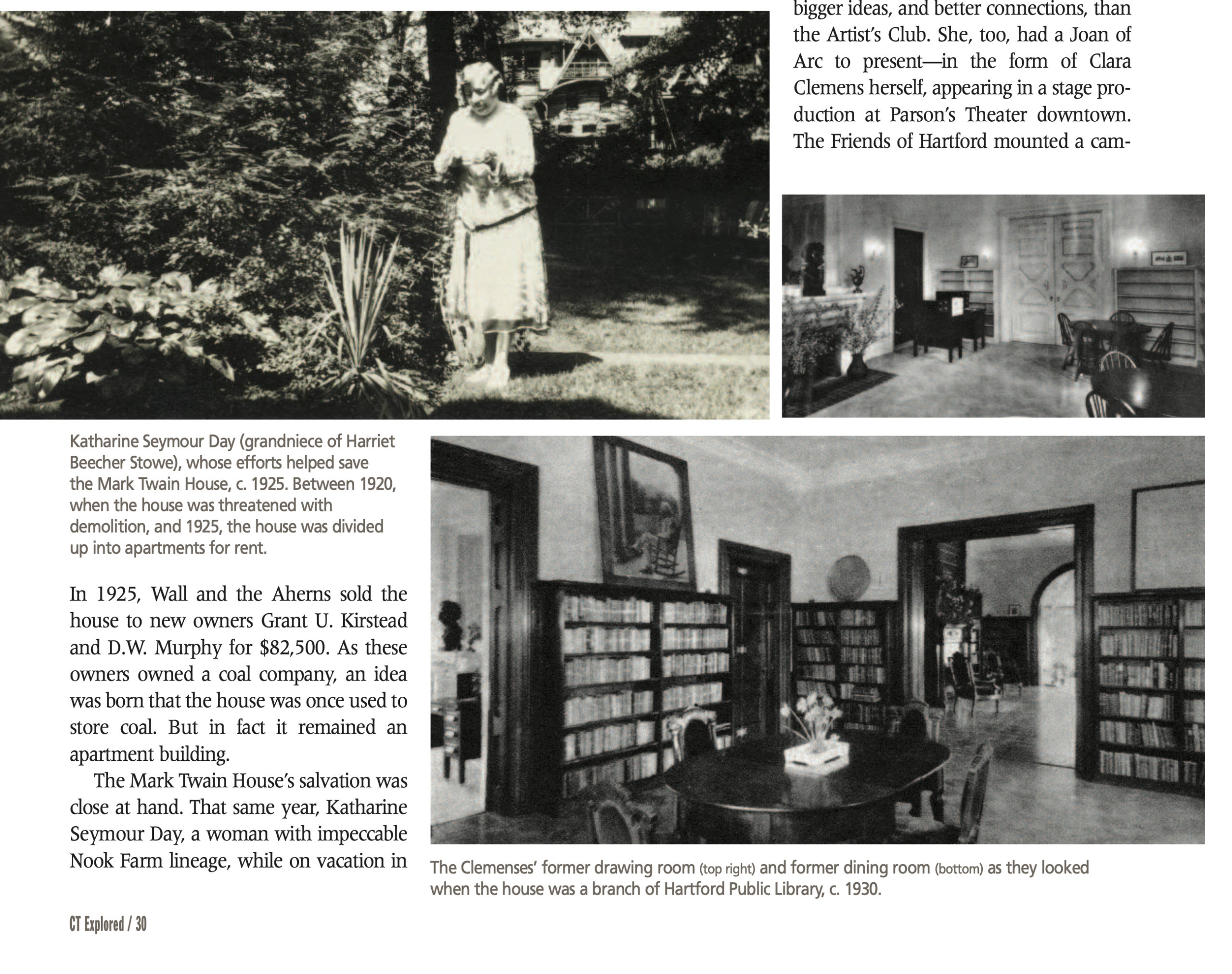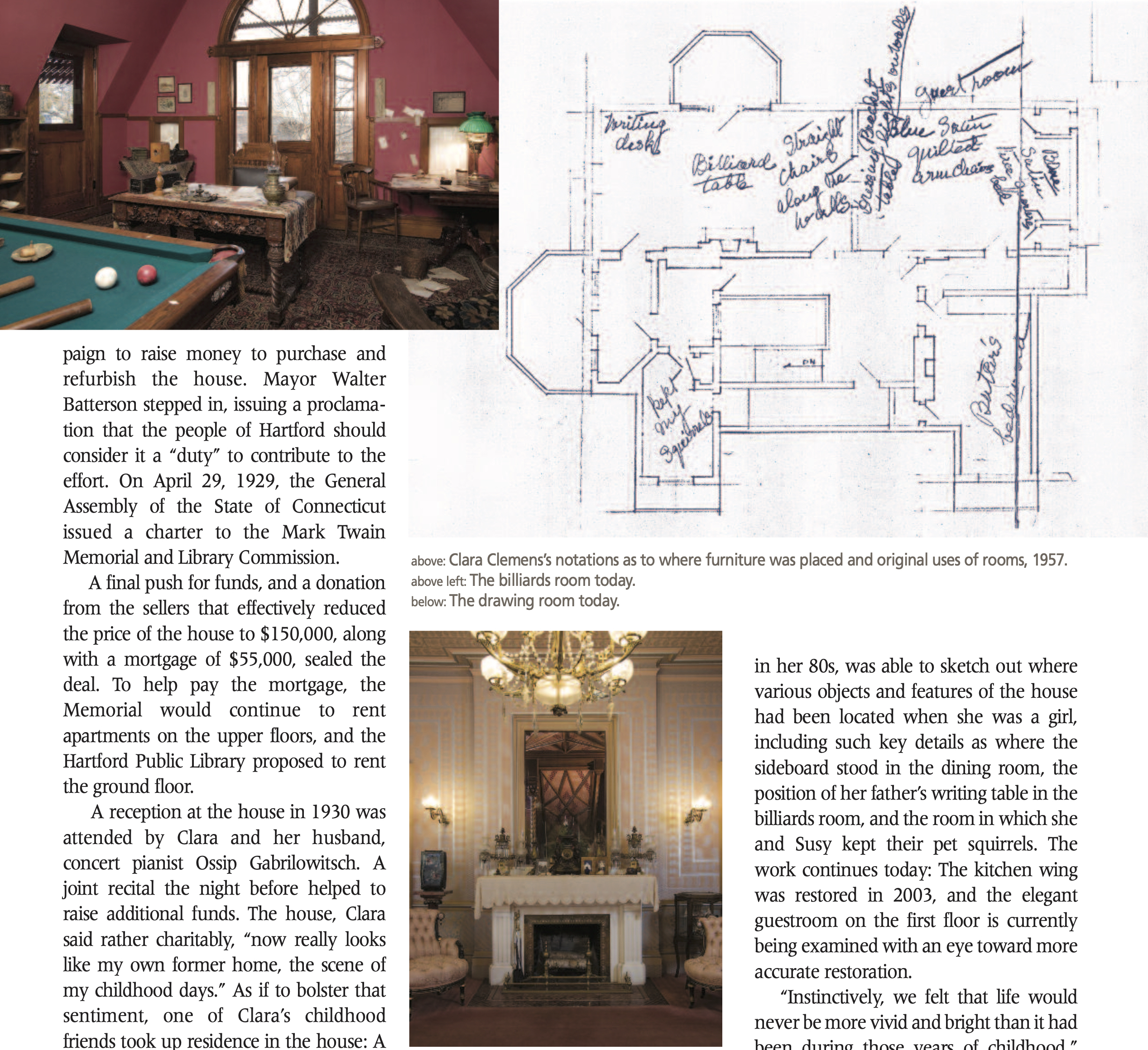(c) Connecticut Explored Inc. Spring 2013
Subscribe/Buy the Issue
In 1920 the grand old Clemens home was on the brink of demolition, and citizens of Hartford—including the sensation-minded young editor of The Hartford Courant—mobilized to save it. But they didn’t reckon with Hartford’s steady habit of long-held grudges.
The story begins in 1890. “I wish there was some way to change our manner of living but that seems next to impossible unless we sell our house,” Olivia Langdon Clemens wrote to her mother in 1890. By June the following year the family’s departure from—if not sale of—its beloved home at 351 Farmington Avenue in Hartford, was a financial necessity for Samuel Langhorne Clemens—Mark Twain—and his family.
The author’s business fortunes had crashed, and he had contracted to write letters from Europe for publication as a way of digging himself out. For a prominent American writer, life in hotels in Paris or Vienna could be more economical than maintaining a mansion such as the one in which the family had lived since 1874.
Before the family sailed, daughters Susy, 19, Clara, 16, and Jean, 11, walked the rooms of the house, recalling the scenes of childhood games, adventures, and misadventures. “We had to leave so much treasured beauty behind,” Clara wrote 40 years later. “…We had showered love on the home itself—the library; the conservatory sweet with the perfume of flowers; the bright bedrooms; and, outside, the trees, the tender eyebrights, the river reflecting clouds and sky.” She remembered snowstorms and crackling fires, Shakespeare’s plays performed in the schoolroom, concerts on the baby upright piano, and popcorn and roasted chestnuts. “We passed from room to room with leaden hearts, looked back and lingered—lingered. An inner voice whispered we should never return, and we never did.”
Initially, the plan was to return when they’d regained their financial footing. When Samuel Clemens came back for a visit alone in 1895 he was overcome with nostalgia, writing to his wife “Livy”: “As soon as I entered the front door I was seized with a furious desire to have us all in this house again and right away, and never go outside the grounds any more forever…. It seemed as if I had burst awake out of a hellish dream, and had never been away, and that you would come drifting down out of those dainty upper regions with the little children tagging after you.”
Tragedy struck the following year, however, when Susy, on a visit to friends in Hartford, was stricken with spinal meningitis and died a horrible death in the house. Clemens wrote his friend and Asylum Hill Congregational Church minister Joseph Twichell thereafter: “It is not the city of Hartford, it is the city of Heartbreak.” The family sold the house in 1903. From that point, the future of this rambling old structure, its chimneys, balconies, and turrets looking down on a rapidly changing city, was tenuous. Clemens’s own actions during the full flower of the family’s Hartford tenancy helped place the house in peril.
By 1884, the author of The Innocents Abroad, The Prince and the Pauper, and the soon-to-be-released Adventures of Huckleberry Finn had shown himself to be a staunch Hartford Republican. After a Missouri youth during which he briefly joined a regiment formed to oppose Northern tyranny, he became devoted to the cause of Lincoln and Grant, married a staunch abolitionist, and cast his vote with the party of progress.
In the early 1880s he stood with the city’s Republican newspaper, The Hartford Daily Courant, in its crusade against the nefarious dealings of Senator James G. Blaine of Maine. Blaine—like the corrupt characters in Twain’s political novel The Gilded Age, co-written with Courant co-owner and editor Charles Dudley Warner in 1873—had taken money from railroads in return for legislative favors.
 In his Autobiography, Clemens describes the smoky scene around the billiards table at 351 Farmington Avenue on June 6, 1884, as he and his friends waited in suspense over the appalling possibility that Blaine would be their party’s nominee. “All these men were Republicans, but they had no affection for Blaine,” he wrote. “For two years, the Hartford Courant had been holding Blaine up to scorn and contumely.” When news arrived that Blaine had been chosen, Clemens said, “the butts of the billiard cues came down on the floor with a bump.”
In his Autobiography, Clemens describes the smoky scene around the billiards table at 351 Farmington Avenue on June 6, 1884, as he and his friends waited in suspense over the appalling possibility that Blaine would be their party’s nominee. “All these men were Republicans, but they had no affection for Blaine,” he wrote. “For two years, the Hartford Courant had been holding Blaine up to scorn and contumely.” When news arrived that Blaine had been chosen, Clemens said, “the butts of the billiard cues came down on the floor with a bump.”
As the Hartford Republicans recovered from their confusion and got their bearings, they overwhelmingly switched from excoriating Blaine to backing him. The Courant, too, swirled around 180 degrees to throw Blaine its support. Clemens, Twichell, and a few others in town wouldn’t sell out, and instead joined the “mugwumps”—the Independent Republicans who backed other candidates. Clemens favored the Democrat Grover Cleveland that year. But despite having previously reported on nearly everything Mark Twain said or did, The Courant didn’t cover the mugwumps’ local activities or Twain’s participation. The whole affair rankled in one Courant editor’s mind and would burst forth nearly four decades later, and nearly doomed Mark Twain’s home to demolition.
The Clemenses sold the house in the literary Nook Farm neighborhood in 1903 for $28,800 to Richard M. Bissell, an executive who was being transferred from the Western Department of The Hartford Fire Insurance Company to the home office. Bissell, who began a 28-year tenure as president of The Hartford around this time, was “tall, distinguished looking, quietly confident and able,” according to a company history. He was, however, later described by a grown son in a memoir as “a somewhat distant figure at home.” His wife Marie Bissell was another matter: She was “a midwesterner who found Hartford society stuffy,” says historian Eugene R.Gaddis. “Even during Prohibition, champagne flowed liberally at her soirées, and on the morning after at least one party, a grand piano was spotted on her front lawn.”
The Bissells’ son, Richard Bissell, Jr., remembered that his brother kept a pet alligator in the conservatory and that his mother “updated the interior [of the house]to eliminate its Victorian darkness.” The Tiffany stenciling in the drawing room, considered woefully out of date, was covered with fashionable, light-colored grass-cloth paper; other stenciled walls were painted over, and chandeliers were taken down.
When the Bissells moved to suburban Farmington in 1917, they leased the house to Kingswood School, a private school for boys aged 10 to 18. The Clemenses’ elegant first-floor guest room became the headmaster’s residence; the library became an assembly hall, the drawing room a library, and the carriage house a gymnasium. A photograph from that time shows a baseball team posed on the hillside below the house, its characteristic decorated brick and conservatory clearly visible in the background.
 In 1920 the Bissells sold the property to a real estate investor, J.J. Wall, and two brothers in the undertaking business, John and Francis Ahern, for $55,000. Two months later, a notice appeared in The Hartford Courant announcing that the new owners proposed to raze it and build an apartment building.
In 1920 the Bissells sold the property to a real estate investor, J.J. Wall, and two brothers in the undertaking business, John and Francis Ahern, for $55,000. Two months later, a notice appeared in The Hartford Courant announcing that the new owners proposed to raze it and build an apartment building.
Reaction was swift. A group called the Artist’s club of Hartford protested, meeting in the studio of a local landscape painter named Nunzio Vayana to plot a strategy to preserve the building. They planned “a campaign which will embrace all parts of the country where there resides one admirer of Mark Twain” and rounded up support from celebrities including President Woodrow Wilson and the tenor Enrico Caruso.
Emile Gauvreau, the energetic and ambitious young editor of The Courant, thought this would be a terrific crusade for his newspaper to take on. But he didn’t reckon on Hartford’s capacity for grudges. “I made my first diplomatic blunder on the paper by starting a crusade to save Mark Twain’s old Hartford home from destruction,” Gauvreau wrote years later. He started a drive for children nationwide to donate their pennies and got Governor Marcus H. Holcomb to throw his weight behind the effort. Gauvreau’s boss, 72-year-old Charles Hopkins Clark, publisher and a figure from Hartford’s Gilded Age, thought otherwise.
Clark had been editor of The Courant back in Charles Dudley Warner’s day. When Warner decided to pursue writing travel books, novels, and belles lettres, the younger man took over most of the newspaper’s editorial functions. He was a booster for his city—it was in a Scribner’s magazine article in 1876 that he put forth the myth that Hartford was the wealthiest city in the country—and he was a booster for the Republican Party. He had even collaborated with Clemens on a collection called Mark Twain’s Library of Humor. In dictating his Autobiography in 1907, Clemens praised Clark’s editorship of The Courant. But none of that mattered to Clark. “I knew Mark Twain,” he said, as Gavreau reported in his memoir. “…When he came to Hartford he gave everybody the idea that he was a Republican. I think he must have been a Democrat all the time. He and his crony, Holy Joe Twichell, voted for Cleveland after we had come out for Blaine. …What in the world possessed you to stir up all this mess about his house? Do you think Hartford will ever forget that he voted for Cleveland?”
The Artists’s Club pressed on. Wall offered to sell the house to the group for $300,000, almost six times what he and the Aherns had paid for it. If they didn’t want to buy, he said, he would “take off that ugly roof” and add three stories to the house. Even Clark, nursing his 1884 Blaine resentments, couldn’t resist the tide of protest this statement raised. The Courant condemned the heavy-handed and obvious extortion. The Artist’s Club organized a fund-raising tea dance, and a young woman dressed as Joan of Arc was to appear on horseback, the whole to be filmed by Vayana. (Clemens’s biography of St. Joan, though little read now, was popular back then then.) The Mark Twain Memorial Association was incorporated.
The crusade, though, slowly fizzled, perhaps because the owners became a little more public relations-conscious. The funds were not raised, and the owners neither tore down the house nor destroyed the elaborately patterned roof of multicolored slate. They simply converted the interior into 11 apartments “with composition board partitions in the larger rooms,” The Courant reported, that could be easily removed “in the event of its being desired to restore the interior to its original condition or as a memorial to Mark Twain.”
 Gauvreau left The Courant to become a pioneer of sensational tabloid journalism with the New York Evening Graphic. (“I Killed My Wife Because She Cooked Fish Balls for Dinner” was a typical headline.) In 1925, Wall and the Aherns sold the house to new owners Grant U. Kirstead and D.W. Murphy for $82,500. As these owners owned a coal company, an idea was born that the house was once used to store coal. But in fact it remained an apartment building.
Gauvreau left The Courant to become a pioneer of sensational tabloid journalism with the New York Evening Graphic. (“I Killed My Wife Because She Cooked Fish Balls for Dinner” was a typical headline.) In 1925, Wall and the Aherns sold the house to new owners Grant U. Kirstead and D.W. Murphy for $82,500. As these owners owned a coal company, an idea was born that the house was once used to store coal. But in fact it remained an apartment building.
The Mark Twain House’s salvation was close at hand. That same year, Katharine Seymour Day, a woman with impeccable Nook Farm lineage, on vacation in New York’s Adirondack Mountains, laid out her own vision for the Mark Twain House—and for the Harriet Beecher Stowe house next door—to fellow vacationers. Day was the grandniece of Harriet Beecher Stowe. She had lived her life in a perpetual state of education, studying painting in Paris and New York and in her forties studying psychology, philosophy, and anthropology at Radcliffe, Columbia, and Berkeley. She told her friends of her vision for a literary center that would take advantage of the two houses’ proximity to one another. Day wrote her mother that the friends approved “my plan for the Stowe house,” but in the same letter expressed her concern for “the state of the Clemens one.”
Back in Hartford, Day pitched into Farmington Avenue zoning battles, challenging the increasing commercialization of the neighborhood, and formed a group called the Friends of Hartford to lobby the city government—“the local Tammany,” as she called them. The Stowe house was fairly safe, as it had remained in the family, but the acquisition of the Clemens house “is the key,” she said. She had bigger ideas, and better connections, than the Artist’s Club. She, too, had a Joan of Arc to present —in the form of Clara Clemens herself, appearing in a stage production at Parson’s Theater downtown. The Friends of Hartford mounted a campaign to raise money to purchase and refurbish the house. Mayor Walter Batterson stepped in, issuing a proclamation that the people of Hartford should consider it a “duty” to contribute to the effort. On April 29, 1929, the General Assembly of the State of Connecticut issued a charter to the Mark Twain Memorial and Library Commission.
A final push for funds, and a donation from the sellers that effectively reduced the price of the house to $150,000, along with a mortgage of $55,000, sealed the deal. To help pay the mortgage, the Memorial would continue to rent apartments on the upper floors, and the Hartford Public Library proposed to rent the ground floor.
 A reception at the house in 1930 was attended by Clara (Clemens) and her husband, concert pianist Ossip Gabrilowitsch. a joint recital the night before helped to raise additional funds. The house, Clara said rather charitably, “now really looks like my own former home, the scene of my childhood days.” As if to bolster that sentiment, one of Clara’s childhood friends took up residence in the house: A Miss Helen Forrest moved into what Clara and Susy had considered the “spooky” guest room on the third floor and used the former billiards room as her living room. An official of the Memorial reported to Clara that Forrest was “just as happy as she can be to live in the home where so many of her happiest days of childhood were spent as guests of the family she adored and still does for that matter.”
A reception at the house in 1930 was attended by Clara (Clemens) and her husband, concert pianist Ossip Gabrilowitsch. a joint recital the night before helped to raise additional funds. The house, Clara said rather charitably, “now really looks like my own former home, the scene of my childhood days.” As if to bolster that sentiment, one of Clara’s childhood friends took up residence in the house: A Miss Helen Forrest moved into what Clara and Susy had considered the “spooky” guest room on the third floor and used the former billiards room as her living room. An official of the Memorial reported to Clara that Forrest was “just as happy as she can be to live in the home where so many of her happiest days of childhood were spent as guests of the family she adored and still does for that matter.”
The house had been saved, but its true restoration remained out of reach. It was not until the 1950s that a new generation determined to transform the building into a museum, marking the start of the building’s return to its former glory. Clara, now in her 80s, was able to sketch out where various objects and features of the house had been located when she was a girl, including such key details as where the sideboard stood in the dining room, the position of her father’s writing table in the billiards room, and the room in which she and Susy kept their pet squirrels. The work continues today: The kitchen wing was restored in 2003, and the elegant guestroom on the first floor is currently being examined with an eye toward more accurate restoration.
“Instinctively, we felt that life would never be more vivid and bright than it had been during those years of childhood,” Clara wrote as she and her sisters sadly parted from their home. That home lives on, conveying to visitors that vividness, despite having come perilously close to destruction in part because of Twain’s political integrity.
Steve Courtney is publicist and publication manager at The Mark Twain House & Museum in Hartford and the author of ‘The Loveliest Home That Ever Was’: The Story of the Mark Twain House in Hartford (Dover Publications, 2011).
Explore!
The Mark Twain House, Hartford
MarkTwainHouse.org
860-247-0998
Mark Twain: Homeschooling the Clemens Way, Summer 2007
Nook Farm: Where Mr. Twain and Mrs. Stowe Built Their Dream Houses, Summer 2011
Sam and Livy Clemens’s Love Story, Winter 2017-2018
Mark Twain, Inventor, Spring 2005
GRATING THE NUTMEG PODCASTS
Episode 21: Our preservation story about the restoration of the Mark Twain House’s Mahogany Suite (second segment)
Episode 52: Mark Twain’s Native American Problem

